Singing Praise for Avian Allies
By Oxbow Senior Creative Designer, Rachel Hennon
It’s no more than 5 minutes after meeting Suzanne Lieberman, and she is tuning me into the utterly energetic and joyful call of a Black-headed Grosbeak. With a bright smile and grateful glimmer in her eye, Suzanne shares her fondness for the Grosbeak’s summer song, and her appreciation for their long-distance migration to Washington all the way from central Mexico where they nest in winter. Though we can’t see the bird, we hear its melodic chirppy notes whistling from the treetops of Oxbow’s alder grove—a 17-year-old restoration site buffering the Snoqualmie River. Suzanne documents the auditory observation on her clipboard, then we continue to concentrate our eyes and ears towards the riparian forest, curious about what other birds we may witness.
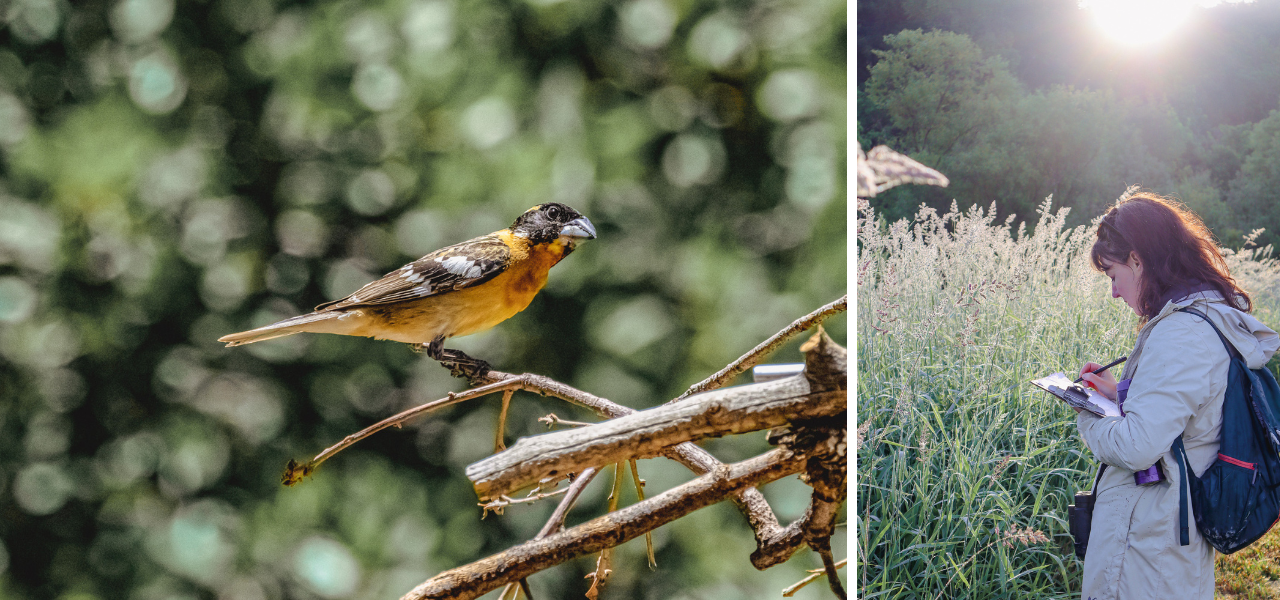
Bird volunteering at Oxbow
Suzanne is one of nine community science volunteers focused on bird monitoring at Oxbow. Every month from April through October, Suzanne leads one of three teams (each comprised of 3 volunteers) through 13 different 10×50 meter plots throughout Oxbow’s southern lowland. This morning, on a Wednesday at 6AM in June, I’m honored to tag along through trails and tall grass with Suzanne, Emily, and Bob. My boots aren’t the only thing soaked while walking and talking with the team. I’m wet behind the ears when it comes to both bird identification and data collection. I ask a lot of questions.
Peeking at the chart on Suzanne’s clipboard, I inquire about the different types of notes she is taking.
Suzanne graciously explains, “Once a month at dawn, we spend exactly 5 minutes at each plot using the naked eye and binoculars, as well as sound, to track the number of different birds that interact with the landscape. We take note of species type, gender, and age. We document the current environmental conditions including temperature, cloud cover, wind, habitat, noise levels…” Before Suzanne can finish her sentence, all 4 of our heads tilt back and eyes dart up to behold a bald eagle soaring south past our plot. I’m in awe. My heart still skips a beat every time I see one. I can’t believe I’m less than 10 minutes into my first birding excursion, and a bald eagle casually passes overhead.
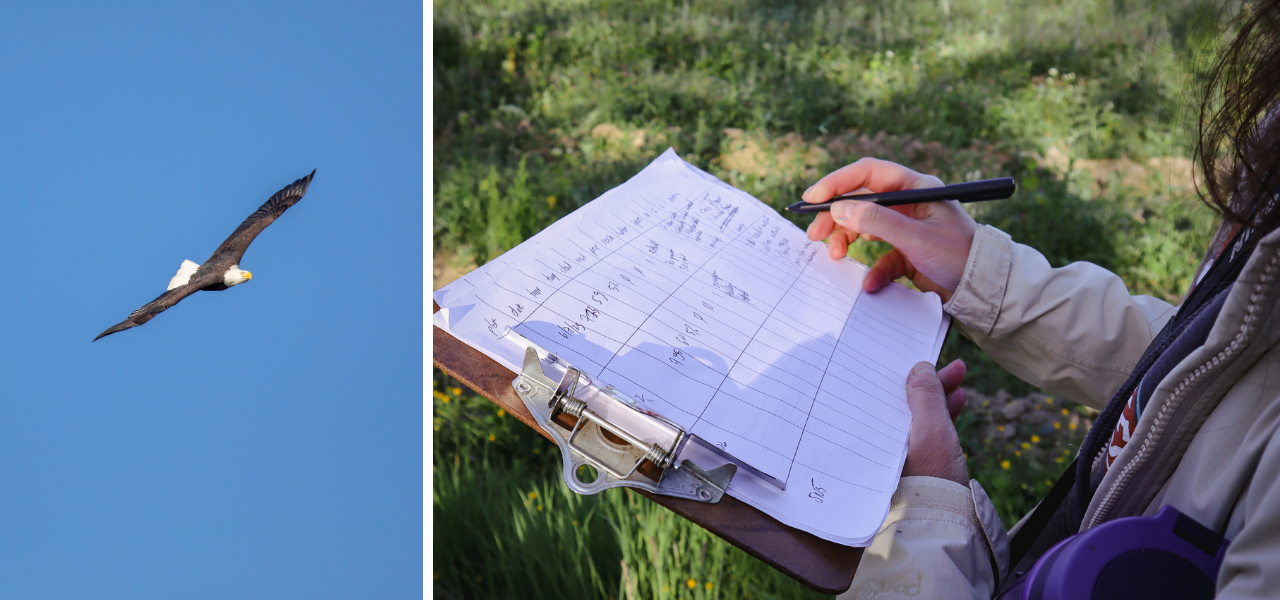
“Can’t count it.”
Uh, what?
I’m confused. What do you mean we can’t count it?!
The team clarifies that they are only recording birds that directly engage with the habitat from the ground to the top of the vegetation. Birds flying over the area may only be noted if they appear to be hunting or seeking perches within the 10×50 meter plot.
This is not an easy task.
For me, it’s hard to focus. It seems like there are hundreds of birds, all speaking different languages, 360 degrees around me.
Suzanne shares, “There is so much bird diversity at Oxbow that it’s sometimes hard to keep moving from plot-to-plot because we become distracted by birds and other wildlife just outside the plots—flyovers, nesting, hunting calls…”
She elaborates, “I spend the bulk of my time trying to be present so I can be as accurate in my count as possible within the 5-minute window—both in terms of noting observations and conditions from the other team members, as well as focusing on my own observations.” Suzanne continues, “While confirmation of a bird finding by ear and sight by both lead data gatherers is optimal, we can also confirm birds by ear only, which is common in the Pacific Northwest given the frequent low light, cloud cover, and prevalence of birds high up in tree canopies. Only as a backup for confirmed audible or visual sightings, we occasionally use the relatively new ‘sound’ function of the Merlin ID app to corroborate more unusual or uncertain bird findings within each plot.”
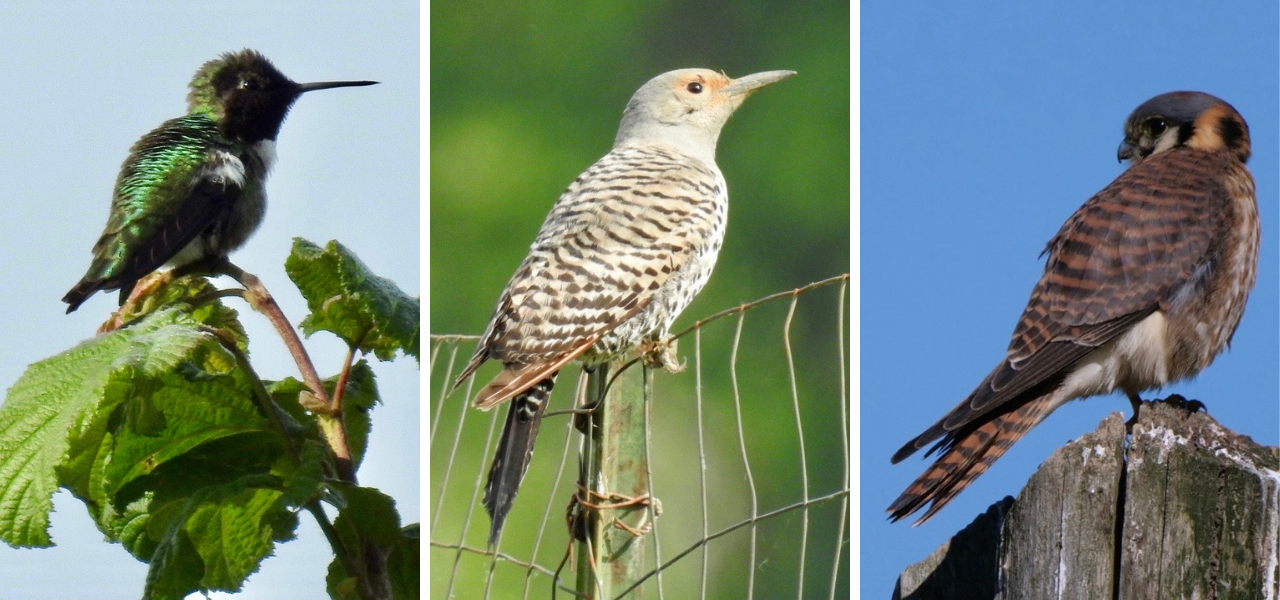
What the bird project is all about
“Ok, so what is the data for?” I ask, while Suzanne notes a Warbling Vireo singing from one of our forested plots.
Suzanne, Emily, and Bob outline bird monitoring work at Oxbow.
I learn that Oxbow’s avian monitoring strategy began in 2016 with a grant from Conservation Research and Education Opportunities International. Together with avian ecologists from University of Washington (Lauren Walker and John Marzluff), Oxbow began monitoring the ways that birds use various habitat types on the property. The conservation team is especially interested in whether forest birds such as Swainson’s Thrush, Wilson’s Warbler, and Pacific Wren are using their growing restoration areas.
Equally important, though, are more general questions about the ways that the complex, intermingling habitats on the property support bird populations and diversity.
The main questions Suzanne and team are helping to answer are:
- What birds are using Oxbow’s 17-year-old restored alder buffer east of the Oxbow Lake?
- As the restoration plantings mature, do they support a more diverse set of bird species? Or does the bird community shift towards birds commonly found in a forest?
- What birds depend on long grass on the field edges, and how can we support them?
- What birds use the invasive blackberry thickets?
- Are there birds that are only found in Oxbow’s upland forest areas?
Suzanne, Emily, and Bob recognize that wildlife conservation is centrally important to Oxbow’s mission, not only because of wildlife’s intrinsic value, but also because of the supporting, provisioning, regulating, and cultural services they provide us. Birds are important because they are highly visible and charismatic animals that connect us to our natural world and its seasons. Birds are wonderful partners in environmental education, as kids are familiar with them and curious about them. Birds are also of particular importance in organic farming because they prey on pest insects and rodents that might otherwise eat crops. And some, such as Rufous Hummingbirds even serve as pollinators. Farms need birds!
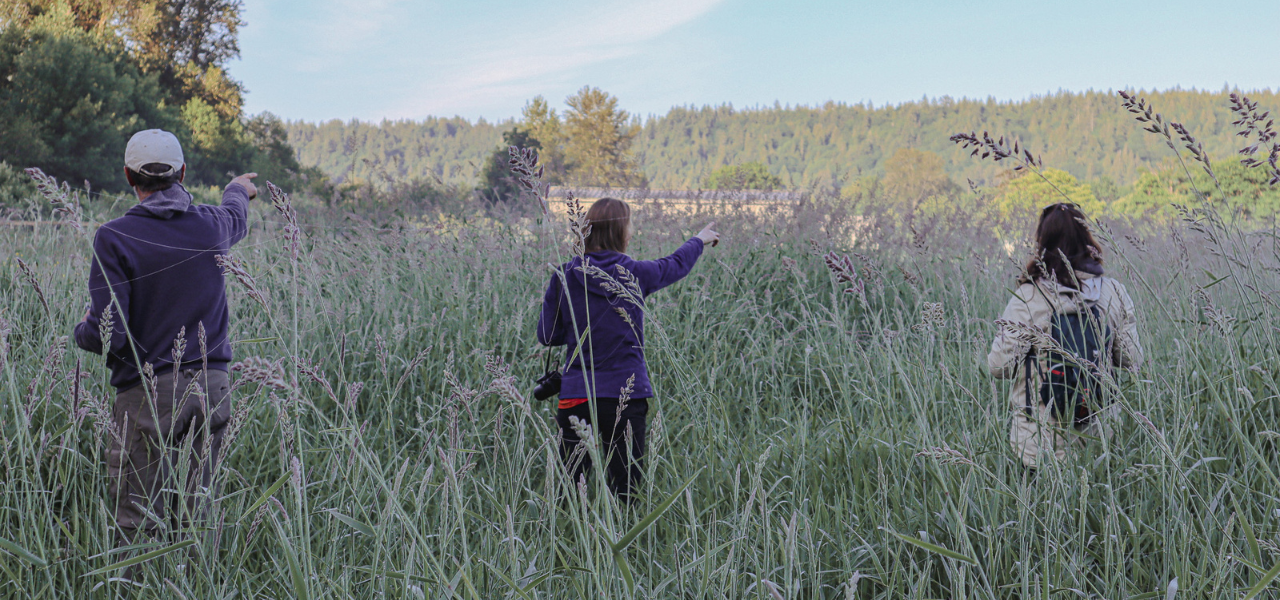
What keeps volunteers coming back
Our team continues trekking from plot to plot—from grassy meadows to cover-cropped farm fields to native forest on the Oxbow Lake Trail. It’s a chirp past 8AM, and the team starts to think about wrapping up because they have day jobs they must get to by 9. I ask Suzanne what it is that keeps her coming back to Oxbow, especially as early as 5AM during the summer?
Suzanne answers, “I keep coming back because I have formed an attachment to these plots and the birds that return to and depend on them. I have been volunteering with Oxbow since 2019. Upon each arrival I’m charmed by our official greeter—a Willow Flycatcher that likes to rest on a stump at the Farm Stand. I look forward to the Barn Swallows and their prolific nests mid-way through each survey. I keep looking for a Merlin I saw one time perched on a post in a fallow field. I can’t help but marvel at the array of spiderwebs, strung throughout the vegetation, catching the light in their dewdrops. During the final 3 plots, I enjoy listening for elusive warblers and nesting ducks on Oxbow Lake. I love meeting and working with other birders who are passionate about the natural world and sustainable land use. Shamelessly, I also look forward to a free basketful of Swiss chard, kale, and other farm bounty at the end of the summer as a thank-you for our volunteer efforts because I am a mostly plant-based eater and I love using these vegetables to concoct delicious savory galettes, quiches, and salads for friends and family. Oxbow is just a magical place.”
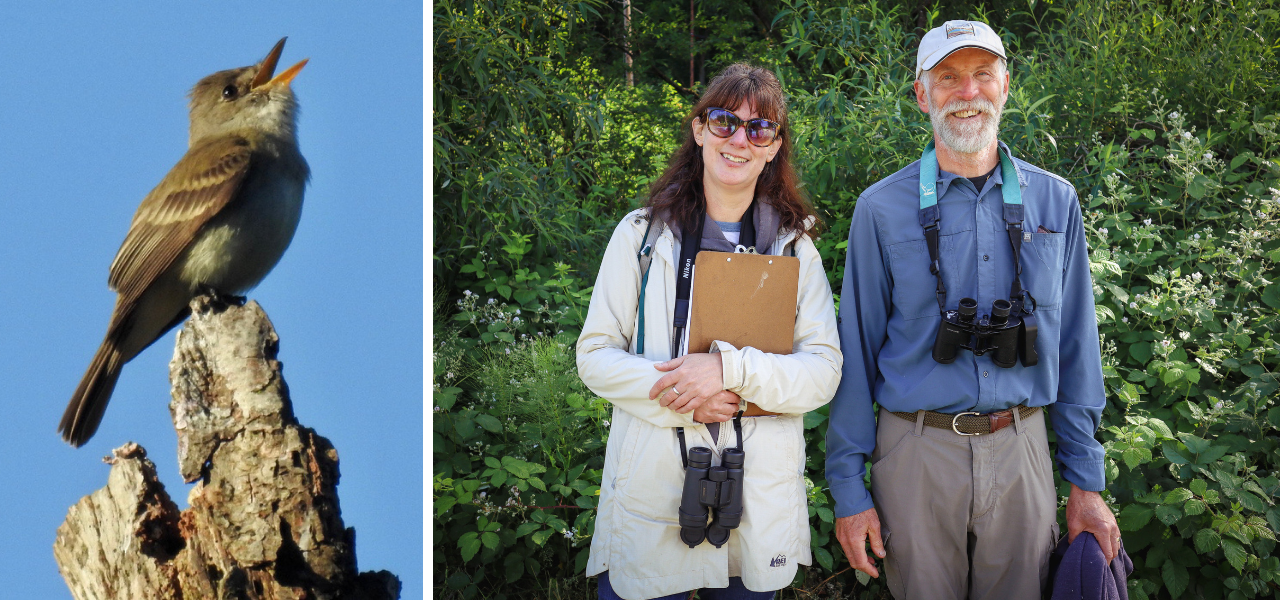
Gratitude for avian allies
As we finish the survey, snap a smiling picture, and say our goodbyes, I can’t thank the volunteers enough. I’m not only inspired by their passion and knowledge, but their generosity in sharing it. Their enthusiasm and dedication are central to improving our understanding of the ways that birds use the complex patchwork of habitats at Oxbow, and how human influences on the landscape – both disruptive and restorative – impact these species. I’m grateful for the hope they’ve given me. My hope for Suzanne and her team is that the praise I’m singing now is at least half as rewarding as a purple finch song, one of her favorites!
Want to deepen connections between you, your community, and ecosystem? There are several volunteer opportunities at Oxbow—from habitat restoration, to food gleaning, to environmental education. Learn more today!
